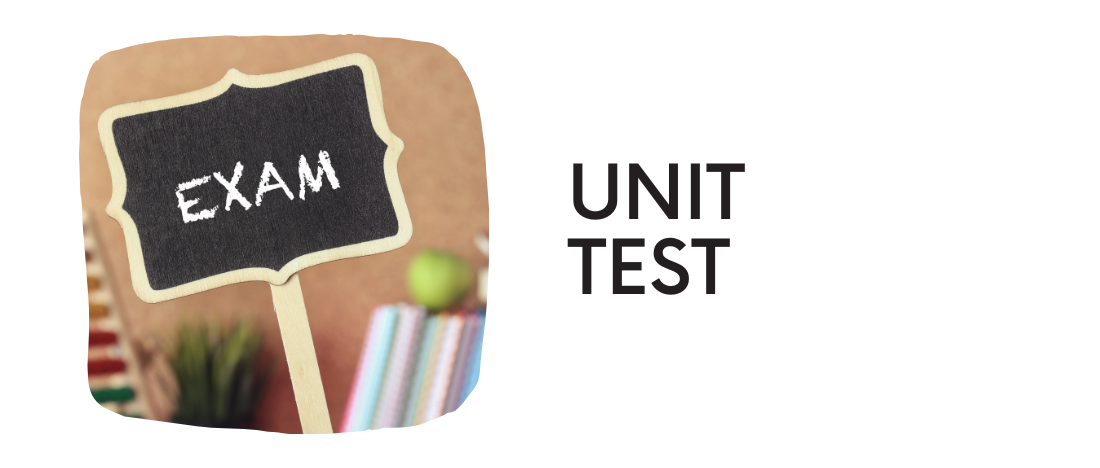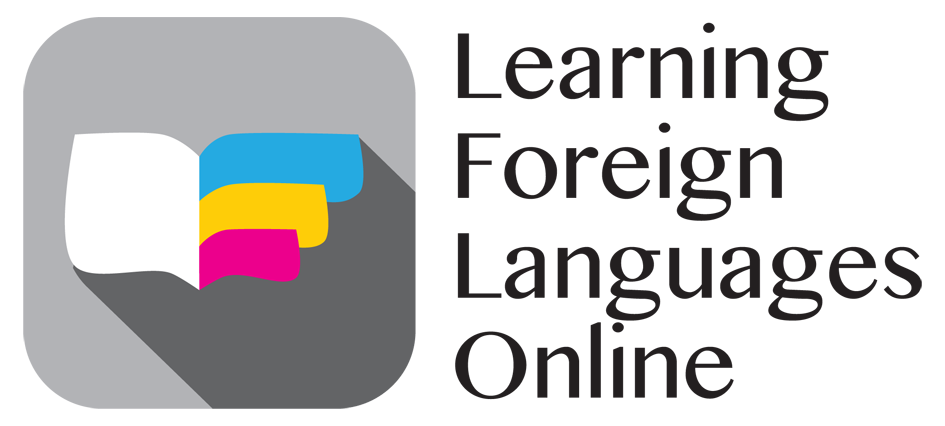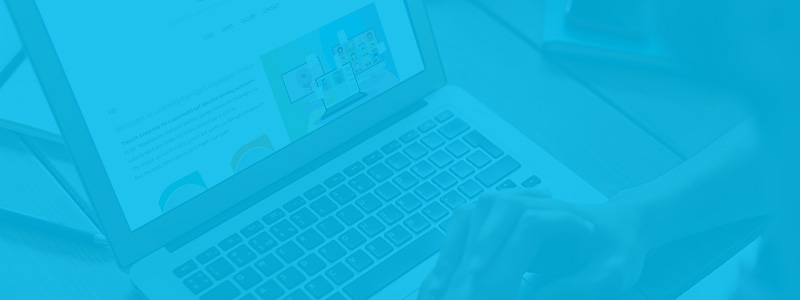
E-course
Monitoring learning
Module 1 | Unit 5
Introduction
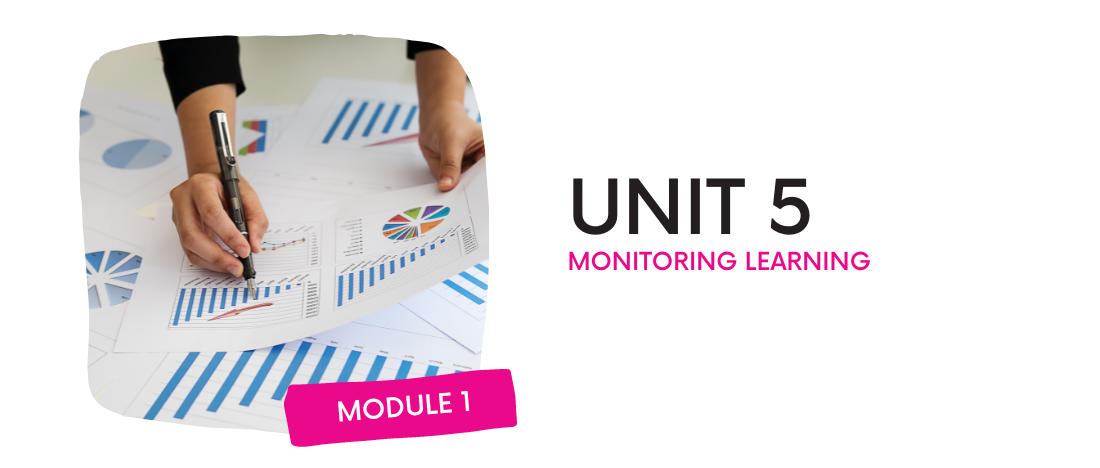
After you have gone through the phase of implementing the learning plan, the last thing you need to know is how to monitor learning. As already mentioned, during the learning process you will need to set milestones to assess your learning. For that reason, learning tracking is the tool you will use that will help you measure your progress, however small or insignificant as it may seem at first. Sometimes we will feel we’re not making any progress at all and it may seem demotivating, but monitoring learning will help you keep track of all the things you have already done and keep you going.
Getting started

Tips

In general, monitoring characterises the process of systematically collecting information throughout the learning journey for four main purposes:
- To learn from experience and to improve practices and activities in the future
- To gain insights on the reliability of the resources used as well as the final results
- To ensure informed future planning for the development of the initiative
- To strengthen the beneficiaries of the action
Monitoring is a regularly iterative task that starts as early as the first stage of learning planning. Monitoring enables results, processes and experiences to be documented and used as a basis for guiding decision-making and learning processes. Monitoring is the checking of progress against plans. Data obtained through monitoring is used to carry out evaluation.
Evaluation is the process of objectively and methodically evaluating a project or in this case a learning plan after it has been finished (or a phase of an ongoing project/plan that has been completed). Evaluations assess the facts and data used to make strategic decisions, enhancing the plan going forward.
Evaluations should aid in drawing conclusions regarding the following five major features of the intervention:
- Relevance
- Effectiveness
- Efficiency
- Impact
- Sustainability
The information obtained throughout the monitoring phase in regard to the above factors serve as the foundation for the evaluative analysis.
Monitoring and Evaluation (M&E)
M&E is a required part for the successful implementation of a learning plan and it can be regarded as a conversation about development and its advancement.
As an essential component of evaluation, monitoring always goes hand in hand with it. In particular, self-monitoring of learning is conducting an assessment process in which you observe your progress and keep records to be able to identify your strengths or weaknesses.
There are two types of self-monitoring:
- Qualitative monitoring, which deals with the quality of things that happen, e.g., how they make you feel, what feels wrong, etc.
- Quantitative monitoring, which deals with counting the reliability of results.
Although both types of monitoring are important, quantitative monitoring works best as it provides you with:
1. Feedback
Use the feedback data you’ll collect to gain a broader perspective on your current progress so that you can focus your study more effectively on the areas that need more practice. This will help you to stay goal-oriented and be directed to work only on parts of language that actually need to be improved further.
2. Intervention strategies
Mechanisms that you can use if you are falling behind and that will help you get back on track and increase your effectiveness. Some of them may be:
- Extending the time of the tasks.
- Practice with Kahoot.
- Gamify your learning with Quizizz.
- Do an activity that has a direct implication on real life.
For example, make a shopping list of the things you want to buy in the target language, follow a recipe to cook, read the directions to go to a place, text message your friends in the target language. Here (preply.com) is a list of possible activities. - Use the target languages in cross-curricular activities , such as maths, geography etc.
- Revision exercises.
- Creative activities to keep you motivated.
3. Learning activities
Through these processes you can decide on the effectiveness of the learning activities you defined in the previous steps and, if necessary, you can make any further changes.
4. Learning content
Since, you’ve finished with the monitoring process you’ll have a complete picture of your profile with your weaknesses and strengths. Based on these results you can adapt the learning content to achieve the highest performance.
Once understood all of the above, it is essential to define a measurement system that will help in the process of evaluating the effectiveness of learning activities.
Some self-monitoring strategies to follow when building your plan are:
- Make an outline for writing tasks, homework etc.
- Use a self-monitoring schedule.
- Double-check everything.
- Use a timer for programming the evaluation activities and to collect data.
- When you finish your assignment evaluate it from an external perspective.
A sample draft of a monitoring plan is presented below:
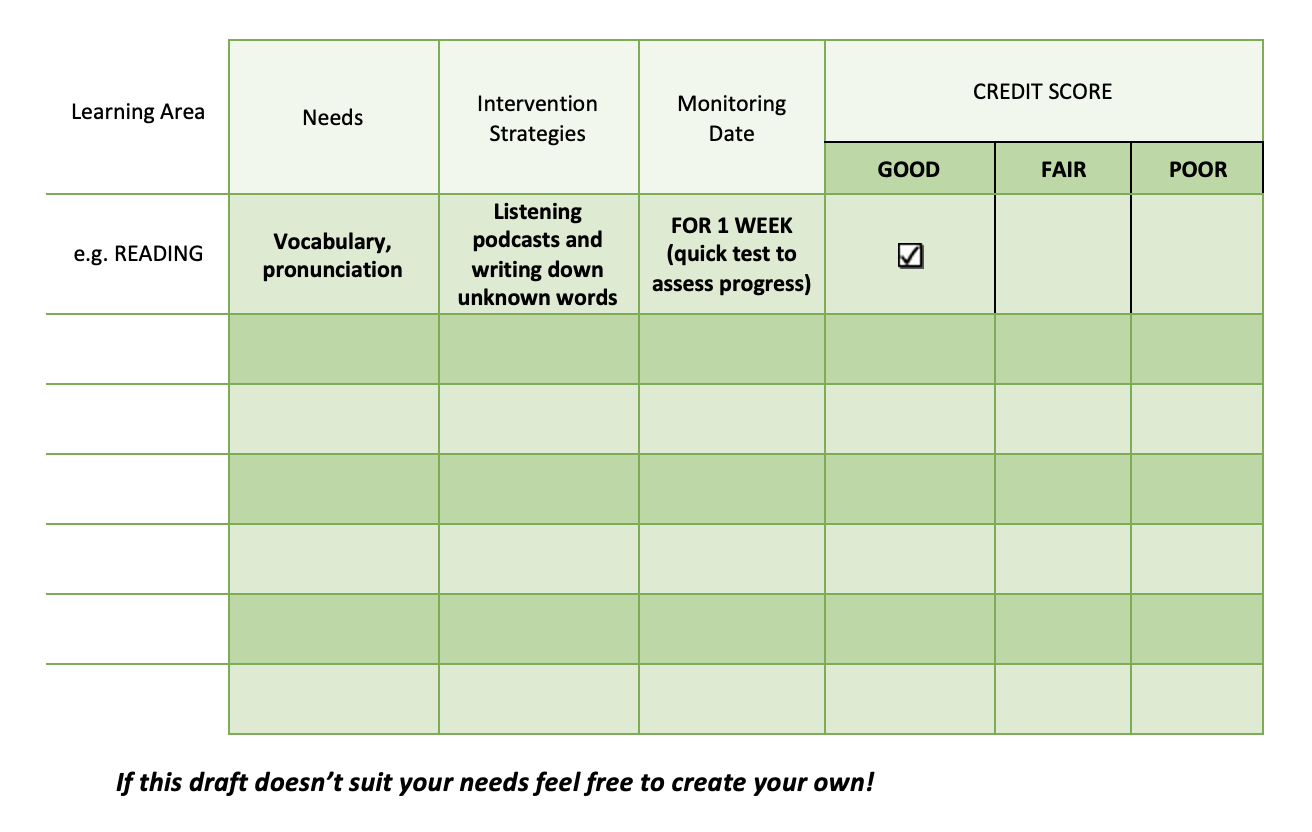
TIP: Carry out your evaluation when the time period you have set has expired. For example, in the template above, it takes place at the end of each week.
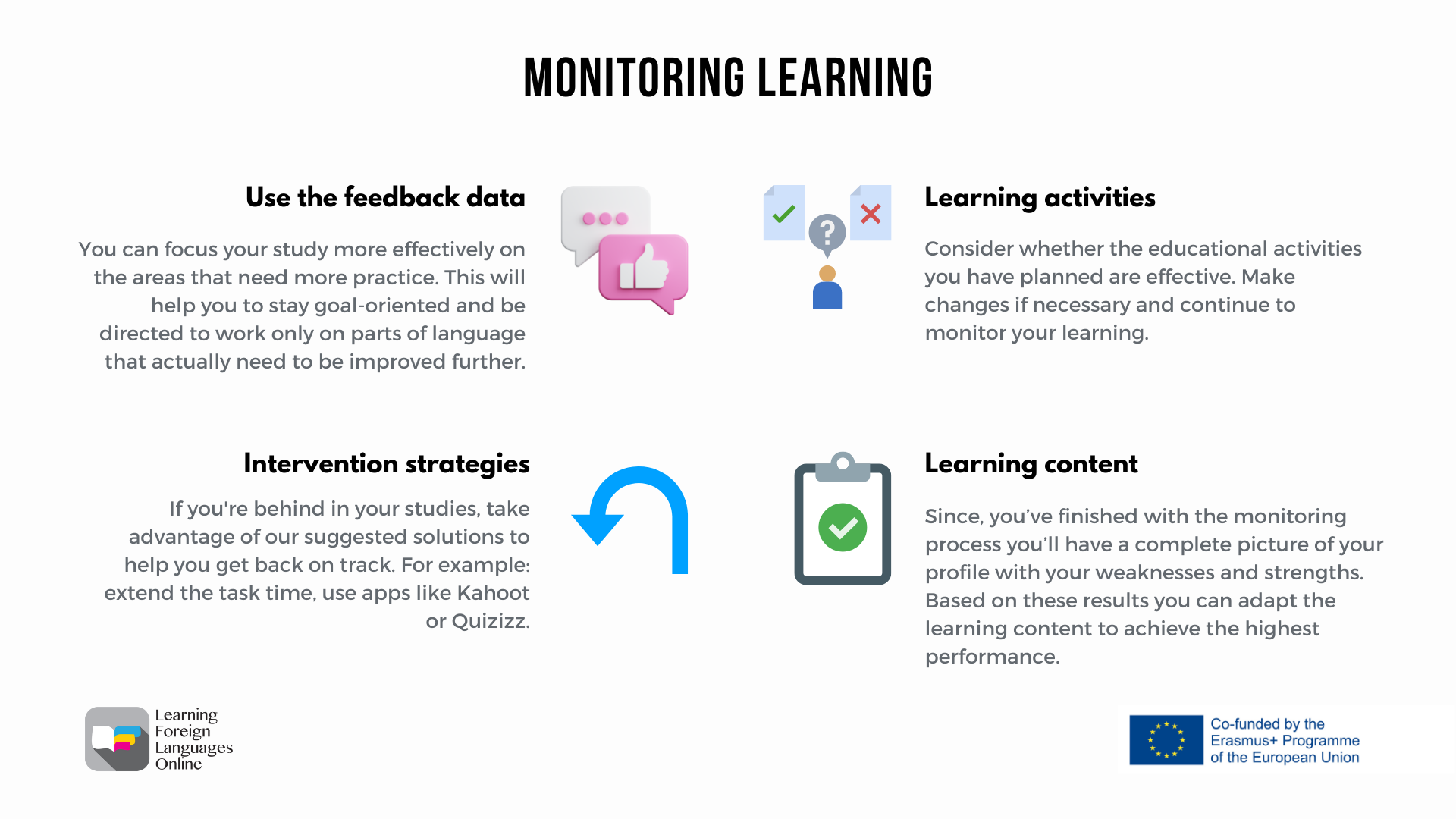
More resources
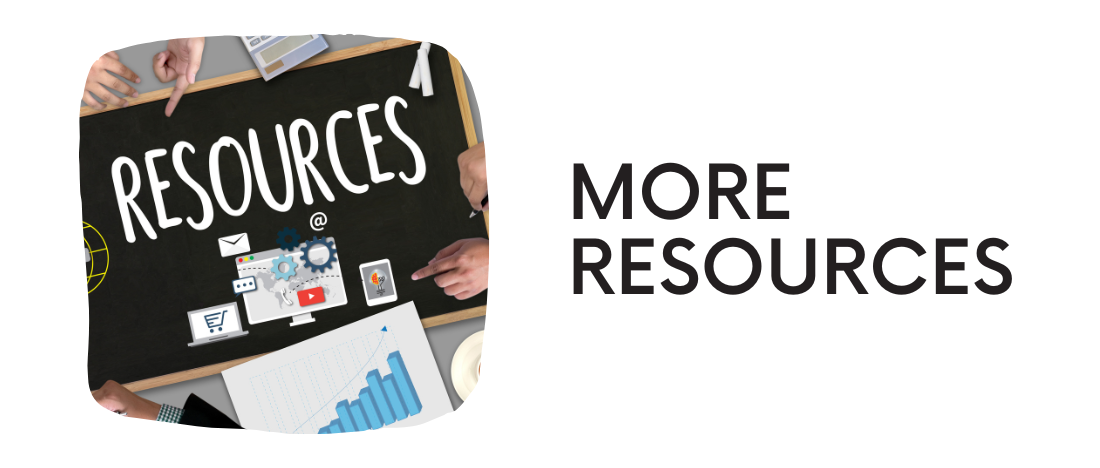
Still want to continue learning about the topic of this unit? Not to worry, we have made a selection of further resources that you can use if you would like to find out more. Just click on the links and keep learning!
Practical tasks
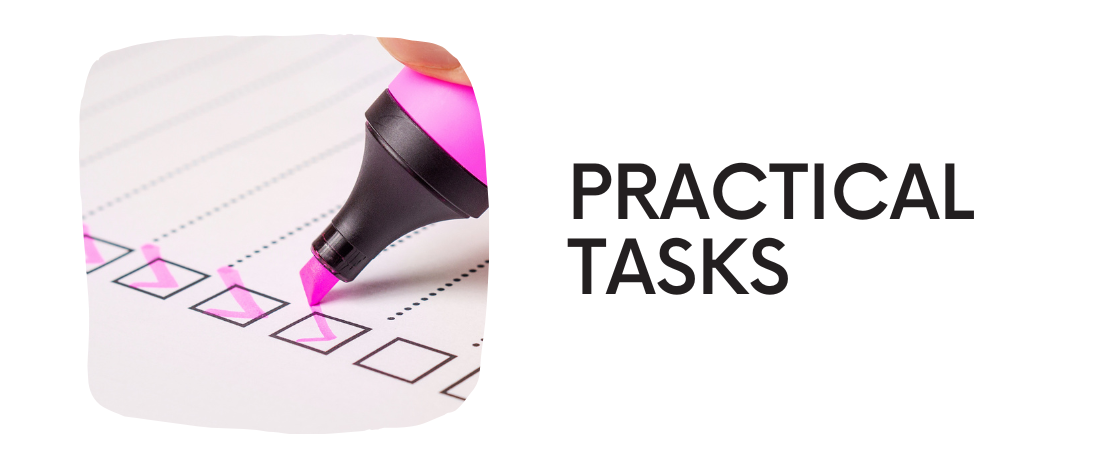
After reading the unit, now try to implement the following tasks:
- The goal is to assess the learning outcomes achieved on a monthly basis, in order to collect and capture manageable portions of feedback on the quality of the project on an ongoing basis. With this in mind, and depending on your learning needs, after the first month of the learning process, test both your writing and listening skills by listening to a song in your target language, imagining a music video, and writing the story of the music video using 200 to 250 words. After you have completed your story, check for any grammatical and vocabulary errors. You can use this exercise after the end of each learning period you have set to monitor your progress. Remember to keep the results of this exercise so that you can compare them with next month’s assessment.
- Adapt the template provided above to monitor the learning plan you have already created in the previous unit. Make a list of your scores and write near to each score the level you’ll want to reach during the next evaluation.
- Since you have the results of the template, write down at least 2 intervention strategies mentioned in the list above that meet the needs of the learning areas you are lagging behind.
- Refine your initial learning plan according to the results to maximize outcome.
- Visit ESL’s website, select the target language, and run the test. The tests consist of 40 questions, and the results will be displayed later. Make notes of the questions you think you found most difficult, so that it will be easier for you to find the answers later (the above website doesn’t contain tests for Polish or Croatian, so run this test for Polish and this for Croatian).
- After finishing the above test, determine the areas you’ll need to further work on and, by using the noted questions, create a new test that you’ll use during the next evaluation period. The test should include exercises and activities that test the language skill you want to improve. Remember though that all skills are essential: You should test Grammar, Listening, Reading comprehension and Vocabulary. If you want to make sure that you test yourself effectively, create at least 2 exercises for each skill with 5-10 items each.
- In order to test and ensure that your indicators are accurate download and fill in the template provided here by following the information provided.
Unit test
